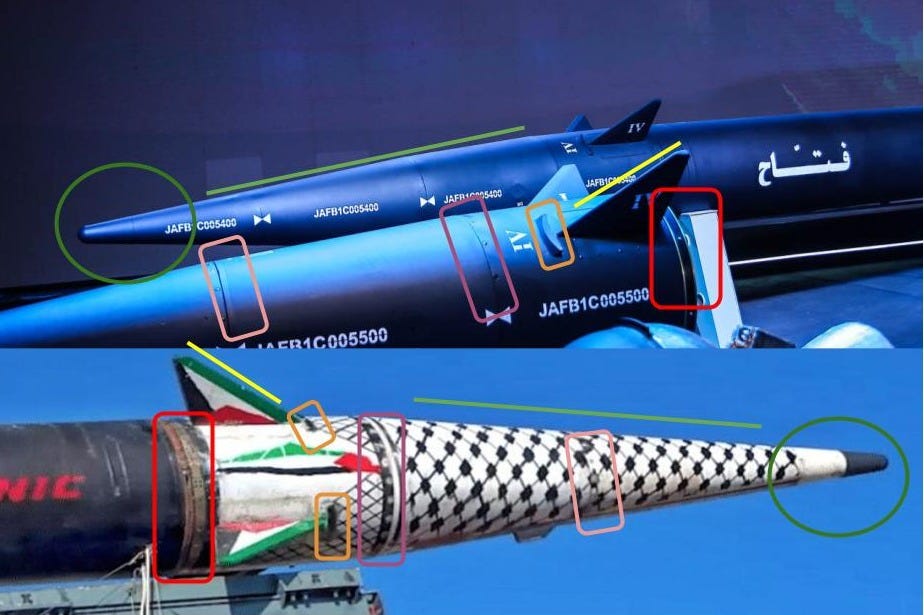Iran is Democratizing Advanced Missile Technologies: The Houthi's Palestine Missile in Context
Analyzing the structural similarities and technological ties between Houthi and Iranian missile designs.
The Palestine-2 missile has swiftly taken center stage in discussions about Houthi military capabilities, overshadowing months of focus on their anti-ship ballistic and cruise missiles as well as their evolving long-range unmanned aerial vehicles (UAV). This hypersonic missile has demonstrated its reach and impact by reportedly striking targets near Jerusalem and crossing Israeli airspace to reach the skies over Tel Aviv on multiple occasions. The resulting debris from both the missile and the interceptors has caused noticeable damage to civilian and metropolitan areas.
The missile was unveiled by the Houthis on September 16, 2024, nearly 11 months after the October 7, 2023, outbreak of the Gaza conflict and just five days ahead of the ten-year anniversary of their takeover of Sana'a and seizure of power in northern Yemen.
Prior to the introduction of the Palestine ballistic missile series, the missiles used by the Houthis against Israel appeared to rely on less advanced liquid propellant systems. In contrast, the Palestine series, particularly this latest iteration, represents a significant technological leap by adopting solid-fuel propulsion. This advancement not only enhances the missile’s reliability and readiness but also suggests improved performance characteristics, such as greater agility and reduced launch preparation time.
But where did the Palestine-2 come from? It is unsurprising that this missile seems to be a hybrid variant, drawing features from the Iranian Fattah and Kheibar Shekan, or potentially combining elements from both alongside technologies from the Fateh missile family.
Like the rest of the Houthis' advanced long-range arsenal, the Palestine-2 bears the unmistakable hallmarks of Iranian design and engineering. Designed for groups like the Houthis in Yemen, the Palestine-2 has been developed with a focus on survivability, precision, and affordability, showcasing a range of sophisticated features that make it a formidable weapon in regional conflicts.
The Palestine-2 missile reportedly has a range of up to 2,150 km and is powered by a two-stage solid-fuel system. It allegedly features stealth technology and can reach speeds of up to Mach 16, though this figure has not been verified by independent sources. While Houthi forces claim the missile can evade advanced Israeli air defense systems such as Iron Dome, multiple launches of Palestine-2 have been successfully intercepted by Arrow, David’s Sling, and THAAD surface-to-air interceptors. Despite these interceptions, the missile’s alleged maneuverability remains a significant concern.

In terms of design, the top section of the Palestine-2 appears structurally similar to the Iranian Fattah-1 missile. The yellow lines suggest symmetry and alignment in the stabilizing fins near the warhead, while the green circles emphasize the similarly extended tip shape on both missiles. Red rectangles draw attention to the comparable joint interface sections where the warhead connects to the missile fuselage, which houses the propulsion system, solid fuel, and the control system (including actuators for steering and stabilizing fins). Pink and purple rectangles showcase two visible warhead joints found on both missiles, although the Palestine-2 screws in the purple rectangle appear slightly larger, closer to each other, and greater in number compared to those of the Fattah-1. Finally, the orange rectangles indicate a strake positioned in front of each of the four stabilizing warhead fins, also known as an aerodynamic fairing—a feature observed previously on the Iranian Kheibar Shekan missile and its Yemeni variant, the Hatem-2.
Keep reading with a 7-day free trial
Subscribe to Basha Report’s Substack to keep reading this post and get 7 days of free access to the full post archives.



